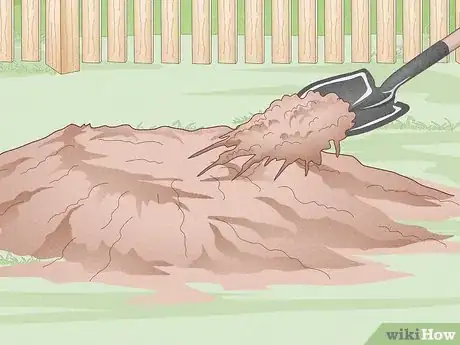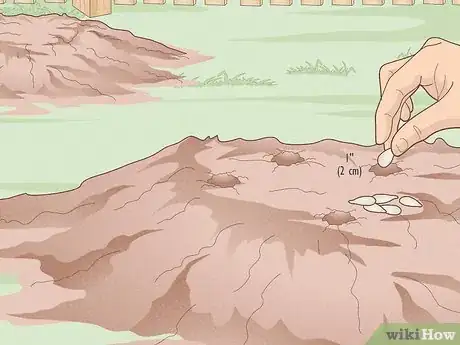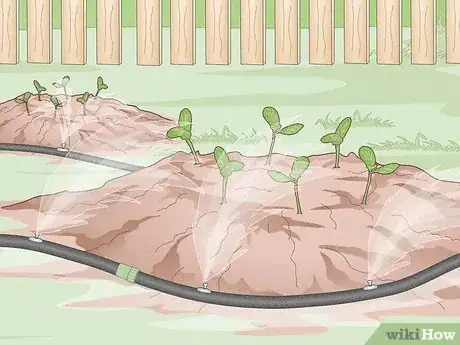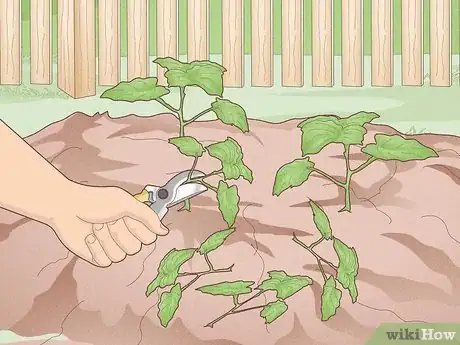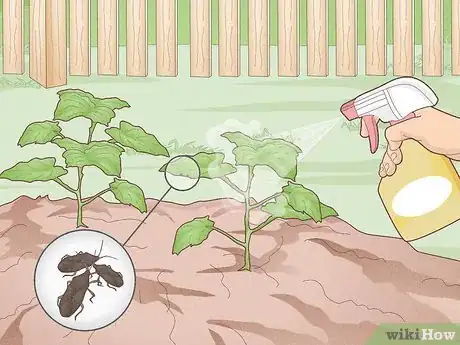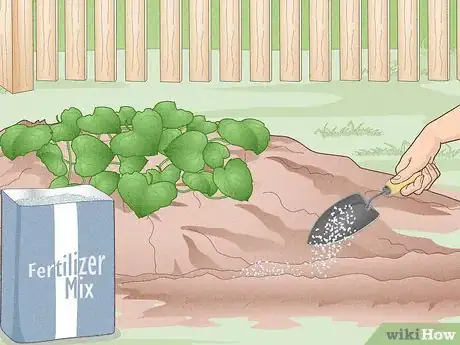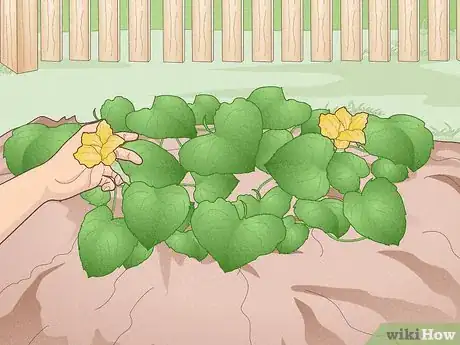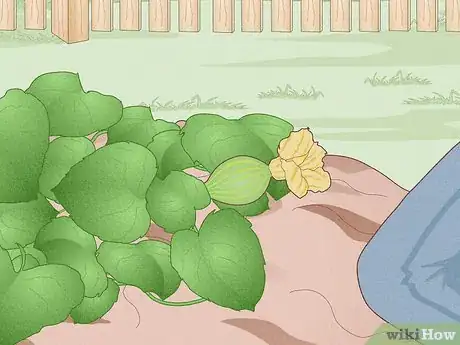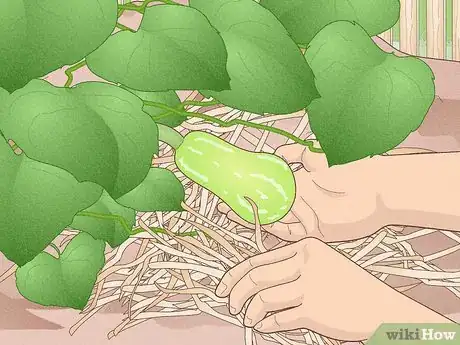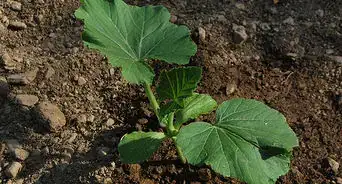This article was co-authored by Andrew Carberry, MPH. Andrew Carberry is a Food Systems Expert and the Senior Program Associate at the Wallace Centere at Winrock International in Little Rock, Arkansas. He has worked in food systems since 2008 and has experience working on farm-to-school projects, food safety programs, and working with local and state coalitions in Arkansas. He is a graduate of the College of William and Mary and holds a Masters degree in public health and nutrition from the University of Tennessee.
wikiHow marks an article as reader-approved once it receives enough positive feedback. In this case, 96% of readers who voted found the article helpful, earning it our reader-approved status.
This article has been viewed 66,463 times.
Hubbard, Butternut, Acorn, Delicata and Spaghetti squash are some of the many varieties that show up in supermarkets in the fall. Pumpkins fall into the same category, but some are good eating while others are fibrous and/or watery. Like so many vegetables and fruits on the market, the commercial varieties are often chosen for criteria other than flavor, but there's a huge variety of types that you can grow yourself.
Steps
Planting Your Squash
-
1Choose varieties based on your climate and the space you have available. If you have a long warm season you can grow almost anything; if it's shorter make sure to pick early-ripening types. Some squash grow on vines that can cover a lot of ground, so if you just have a 12 x 12 foot space, you're better off with a bush variety. Most details will be found on the packaging. Here are a few basics to consider:[1]
- Butternut squash. This type of squash is bottle-shaped with a light brown rind. It is one of the most popular, common, and arguably most delicious. This type has a rich flavor and a smooth texture, in addition to a natural resistance to squash vine borers. They will store for six months or longer.
- Buttercup squash. This type isn't too different from the butternut squash, but it does mature faster than butternut or hubbard. It is good for areas with a shorter, cooler growing season. Each plant will likely grow vigorously and produce heavy crops of squat, green fruits. This type stores for four to six months.
- Hubbard squash and kabocha squash. These two types are often clumped together due to their similarities. They can be medium-sized or they can be absolutely huge. In general, they have drier flesh than most other winter squash. Their color varies by variety, and all varieties will store for four to six months.
- Delicata squash and dumpling squash. Delicate squash are cylinder-shaped and dumpling squash are pumpkin-shaped. They both produce single-serving-size, ivory-colored fruits with green stripes that turn orange when stored. If you live in a cool climate, these are pretty easy to grow. They are fast to mature and will store for three to five months.
- Acorn squash. This type is a ribbed, round fruit with a gold or green rinds. They also mature quickly and will store for at least three months. They are them popular in areas with short summers as there maturation process doesn't take much time.
- Spaghetti squash. These are so named because they are full of stringy fibers that look like pasta. The oblong fruits have smooth rinds that vary from tan to orange, and they will store for three to six months.
-
2Aim to plant your seeds after the last frost. You should plant your squash seeds at the beginning of spring when the soil has warmed to at least 60°F (15°C). Alternatively, you can plant them indoors under bright, fluorescent lights.
- In zone 6 and warmer, you can even plant your seeds in early summer. You should stop planting about 14 weeks before the first expected "frost."[2] If you have a short growing season, you can start growing them indoors and then transfer them to the outside when all threat of winter has passed.
- If you are planting them inside, use biodegradable pots, such as peat pots, so that you can plant the entire pot when you transplant them outside. Removing squash from a plastic pot can disturb their roots and stunt their growth.[3]
Advertisement -
3Prepare your soil. Squash like warm conditions with soil that is fertile, well-drained, and has a pH of 6 to 6.5 To get good growth and production, you'll need to add lots of organic matter to your garden. Rotted manure and compost are the best for getting your plants the nutrients they need. Dig them in deeply so that the squash's roots will penetrate easily.
- Squash are often planted in "hills." These help the squash grow by warming the soil more quickly and increasing drainage. Even in well-drained areas, hills can give your plants a boost by providing warm soil as they begin growing.
- Hills don't always literally mean a raised area. If you have fast-draining soil and a drier climate, you might actually make depressions, with a wide ridge around them, to hold water. Add some extra compost/manure to the area under your hills, too.
-
4Plant six seeds per hill about an inch (2 cm) deep in a sunny spot. You want each hill to be part of a 3-ft wide row (they need their space). Leave about 5 to 6 feet (2 meters) between hills. Loosen the soil for up to a foot below the surface to ensure adequate drainage – you can mix in manure or compost at this step, too.
- They should appear in about 10 days. If you have a short season, you can get a jump on your growing time by planting them indoors, but if you plant too early and the squash become rootbound in their pots, it will actually stunt their growth.
- Upon planting, water them well. They need the initial burst of water to get going.
Caring for Your Squash
-
1Give your plants about 1 inch (2.5 cm) of water a week. In most climes, this is enough to keep your plants going strong. However, if you live in a particularly dry climate you can use flood-style irrigation every 2-3 weeks.
- Remove the weeds so they don't steal your water; a lack of water can stunt your plants, and weeds will use the nutrients you took all that trouble to dig into your soil.
- A drip system is nice but if you don't want to do that, simple trenches between the hills will help you get the water where you want it once the vines start getting rampant.
- Watering in the early morning allows the water to evaporate; this is good because water standing on leaves can create good conditions for disease.
- On hot days, it is normal for leaves to wilt a little bit during the heat of the day, but they will often firm back up in the evening.[4] That said, if leaves are wilted early in the day before it is too hot, your plants need more water.
-
2Thin your plants. Once your plants have put on a few leaves (this is called "germinating"), cull all but two or three at the very most per hill, leaving only the most vigorous plants. There simply isn't enough room for all of them to grow to adulthood.
- At this stage, you may want to set up row covers to protect your little plants from insects and make sure they grow to full capacity.
-
3Watch out for bugs and disease. In the US, squash bugs and squash vine borers can do in a vine in no time. Dark gray squash bugs lurk under the leaves and suck the plant's juices. Borers are a caterpillar or a small moth that bores into the stems, killing the stem beyond the damage. Watch for their eggs under the leaves and along the ground. If you live in Europe you don't have those insects but other things can still damage your plants, so be vigilant!
- Floating row covers can help with this problem, though you'll have to remove them when your female flowers show up so they can be pollinated. Aphids can be controlled with soap spray or water and as a last result, use neem.
- "Powdery mildew" is another culprit, though non-bug, that you need to look out for. In the second half of their growing, spray the plants with a mixture of one part milk to six parts water every two weeks to fend off this disease[5]
-
4Consider adding more fertilizer. In about a month, you can add a side dressing of fertilizer to the vines – about 10 inches on either side. Don't dig too close or you'll damage the roots they send down at each leaf node.
- They won't be fully ripe for about 80 to 110 days, depending on the variety you've planted.[6] There's still plenty of time for them to absorb fertilizer.
-
5Look for flowers. By this point, you should start seeing flowers. The first flowers are usually male and will make no fruit, but they do train the bees. The female flowers are fewer and recognizable by the swelling below the base of the flower. This swelling is your future squash.
- If they don't form into squash, you may not have enough bees to pollinate them. You'll have to pollinate them yourself by going out early in the morning and taking the central pollen-covered organ in the male flower and brushing it all over the counterpart in the female flowers.
-
6Watch the swelling grow. You'll know if the pollination was a success if the flower wilts and that swelling grows visibly in the next couple of days. At this point, all you have to do is keep your vines watered and weeded, and watch out for bugs or disease.
- You don't want wet soil all the time; during a warm summer without rain you'll probably water every few days or so. Watch for wilted leaves, that means they definitely need a drink.
-
7Consider using straw underneath developing squash. As your squash begin to grow, you can carefully put a bed of straw under them if you like, to keep them off the ground and free of blemishes and rot. However, rot shouldn't be a problem if you don't overwater or the squash isn't forming in a wet depression.
Harvesting and Storing Your Squash
-
1Reap the fruits of your labor. Winter squash are generally ripe when you can no longer pierce the skin with your fingernail. The surest thing is to leave them on the vine until the vines start to die back, but you should definitely get them in before frost. That being said, immature fruits don't store well, so be sure to keep them growing for as long as possible. You'll likely get three to five squash per plant.[7]
- Clip them off the vines with clippers and leave as much stem as you can, at least around an inch.
- Don't lift them by the stem; if it comes off the squash will rot. Take care not to damage the skins as that would create an entry point for rot.
-
2Cure the squash for storage. This means leaving the better storing varieties in a warm place for 3-5 days so that the skins will harden up further, protecting them from fungus and bacteria. Butternut, Hubbard and related types (C. maxima and C. moschata) benefit from curing. Acorn and Delicata-type squash are not good storers, and trying to cure them can actually make them last less time, so you'll want to keep them cool from harvest, and use them within 2-3 months.
- A "warm" place should be 70 to 80°F (21 to 26°C).[8] Before this stage, you may wish to clean them off with a damp, clean cloth to get rid of any dirt that could fester on the plant. The curing process seals the skins and dries the stem, leaving them ready for use.
-
3Keep your squash in a cool place. It shouldn't be too dry or too wet. A cool room of a house, an unheated sun porch if it doesn't freeze, a cool cellar if it's not too damp or musty, are all possibilities – even under your bed could work.
- Keep your eyes open for signs of rot, or you might find a fermenting puddle where your squash were. Checking every week or two should be sufficient.
Community Q&A
-
QuestionIhave had butternut squash in the ground for about 2 months, many flowers, no squash as yet. If I find the male flowers to manually pollenate the female flower, how likely is it that I will produce?
 NinoxTop AnswererManual pollination is very effective on squashes. Cut the male flower and bring it near a female flower. Then take pollen with a small brush and put it on the pistil. A small squash should appear within 3 days.
NinoxTop AnswererManual pollination is very effective on squashes. Cut the male flower and bring it near a female flower. Then take pollen with a small brush and put it on the pistil. A small squash should appear within 3 days.
Warnings
- Growing squash can be addictive. The fast growth, instant gratification of seeing them appear and grow, and the immense variety of colors, shapes and sizes available might make you want more garden space every year.⧼thumbs_response⧽
References
- ↑ http://www.motherearthnews.com/organic-gardening/growing-winter-squash-zmaz10jjzraw.aspx#ixzz3DVXvm6yD
- ↑ http://www.motherearthnews.com/organic-gardening/growing-winter-squash-zmaz10jjzraw.aspx#axzz3DVXWiRBo
- ↑ http://www.harvesttotable.com/2009/03/how_to_grow_winter_squash/
- ↑ http://www.harvesttotable.com/2009/03/how_to_grow_winter_squash/
- ↑ http://www.motherearthnews.com/organic-gardening/growing-winter-squash-zmaz10jjzraw.aspx?PageId=2#axzz3DVXWiRBo
- ↑ http://www.gardeningknowhow.com/edible/vegetables/squash/growing-winter-squash.htm
- ↑ http://www.motherearthnews.com/organic-gardening/growing-winter-squash-zmaz10jjzraw.aspx?PageId=2#axzz3DVXWiRBo
- ↑ http://www.gardeningknowhow.com/edible/vegetables/squash/growing-winter-squash.htm
About This Article
To grow winter squash, start by planting your seeds after the last frost in soil that is fertile, well-drained, and has a pH of 6-6.5. You can get the pH levels right by adding rotted manure and compost to your soil. Next, plant 6 seeds per hill or mound about an inch deep in a sunny spot, 5-6 feet away from the next mound of seeds. Immediately after planting, water your seeds well, then make sure to give your plants about 1 inch of water weekly until you harvest your squash. For more tips from our Gardening reviewer, including how to harvest and store your squash, keep reading!


